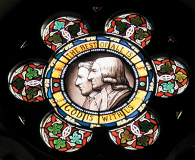Wherever John Wesley went, crowds gathered, often walking great distances to hear him speak. Wesley became, if you will, the rock star of his day. More than 500 Anglican clergy, inspired by the man and his message of the evangelical gospel and holy living, became his followers in what were known as “Methodist Societies” within the church.
 His brother, Charles, meanwhile, no mean preacher in his own right, turned his passion to the writing of hymns, sung at Methodist gatherings in fields, chapels and market squares. In fact, Charles Wesley wrote more than 3,000 hymns, becoming perhaps the most famous hymn lyricist of all time. To this day, Wesley’s hymns are a part of every Protestant hymnal in the world, including the popular Christmas carol “Hark, the Herald Angels Sing,” and anthems such as “O For a Thousand Tongues,” “And Can It Be” and “Love Divine, All Loves Excelling."
His brother, Charles, meanwhile, no mean preacher in his own right, turned his passion to the writing of hymns, sung at Methodist gatherings in fields, chapels and market squares. In fact, Charles Wesley wrote more than 3,000 hymns, becoming perhaps the most famous hymn lyricist of all time. To this day, Wesley’s hymns are a part of every Protestant hymnal in the world, including the popular Christmas carol “Hark, the Herald Angels Sing,” and anthems such as “O For a Thousand Tongues,” “And Can It Be” and “Love Divine, All Loves Excelling."
It may be a truism, but activism is never popular with the Establishment. The Wesley brothers and their swelling following were controversial within the Church of England. Among Wesley’s contentious practices, sidestepping the formal organization of the Church was certainly one. Wesley encouraged lay preachers, and (undoubtedly influenced by his own mother) advocated emancipation and education for women. He established chapels, commissioned and ordained pastors on his own authority, and used his influence championing what we would call today “social justice” and the improvement of human life.
Pulpits of the Anglican churches were often closed to the Wesley brothers. When John Wesley returned to Epworth in 1742, even the pulpit of St. Andrews Church was denied him. That Sunday evening, John stood on the table tomb of his father in the churchyard and preached to the huge crowd that gathered, many walking for miles to hear him. In fact, he put up at the Red Lion Inn on the Market Square and stayed a week. Every evening, the crowds gathered to listen to him preach at the base of the market cross outside the inn.
John Wesley returned to Epworth as often as his travels would allow, staying at the Red Lion, preaching and greeting his followers and fans. In 1784, when he was 81, he wrote, “I rode to Epworth, which I still love beyond most places in the world.”
The Wesley brothers never intended to start their own church denomination. During their lifetime, the Methodist Societies remained a movement within the Established Church. John Wesley died in 1791, predeceased by his brother in 1788. Only after their deaths did a final break with the Anglican establishment create what went on to become the Methodist Church—the largest Protestant denomination in the English-speaking world.
For all that the Wesleys proved the proverbial thorn in the side of the Established Church, there are many Methodist chapels, across northern England’s mining villages in particular, that were built for the workers and their families by mine and mill owners. Ironically, while those owners themselves worshipped at the more respectable Church of England, they were happy to encourage Methodism in the working class. After all, workers whose lives were governed by the principles of healthy, holy and temperate living of the Wesleyan faith were just better workers
Roughly a century after the passing of the brothers, the General Conference of the Methodist Church decreed that a church was to be built in Epworth in memory of John and Charles Wesley. The Wesley Memorial Church was completed in 1889. The stained-glass window at the front of the church depicts Christ commissioning his disciples to go into all the world with the gospel. The roundel above contains life-size portraits of John and Charles Wesley taken from their memorial in Westminster Abbey. Above their stained-glass portraits arches the inscription believed to be John Wesley’s last words: “The best of all is, God is with us.”


